Charm of Espelette, France, puts stop sign on road trip
- Share via
I was going to Biarritz. But then Kimberley, an old friend who spends summers in France, suggests I come a few days early and join her on a road trip to nearby St.-Jean-de-Luz. She will pick me up in a rental car at the BAB airport (Biarritz-Anglet-Bayonne) and we'll scoot down the Atlantic coast.
Perfect.
Our rental is the most emblematic of all French cars, a Citroën 2CV, at least 50 years old and originally built to help get French farmers and their donkeys off the roads after World War II. The French call it a deux chevaux because, with its two-cylinder engine, it moseys along at a top speed of about 30 mph, about the same as a galloping horse.
As I scissor myself into the low-slung passenger seat, Kimberley starts the engine, which trembles, wheezes and eventually announces ignition with a pop-pop-pop that startles me. She double-pumps the clutch, wrestles the shift stick into first, and off we lurch, bouncing down the road.
Instead of taking the toll highway to St.-Jean, (which would be like driving a Vespa on the freeway), we choose a loop drive through the French Basque country. Sensing my nervousness, Kimberley exclaims, "Come on — it's an adventure!"
And it is. Particularly when the GPS device on her phone doesn't work and we get lost not 10 minutes out of Biarritz. Just as it starts raining. Hard. With thunder and lightning and hail — oh my!
There are no directional signs, no highway markers, nothing. But the countryside is spectacular. Rolling green hills, stately sycamores lining narrow country roads, the occasional white stone farmhouse with red, green or blue trim.
Just as the September rain lets up we find ourselves in a strange little village with cobblestone streets and houses hung with garlands of red peppers and nary a soul in sight. We have landed, according to the sign on the post office, in Espelette.
After seeking refuge in the first café we encounter, we meet its owner, André Darraidou, formerly mayor of the town, who convinces us that traveling to St.-Jean-de-Luz that night in our deux chevaux is a ridiculous idea.
Darraidou, who also owns the Hôtel Euzkadi above the café, which, unfortunately, is booked, makes a call and finds us two rooms at the nearby Hôtel Chilhar. There, over a dinner of veal and the local specialty, pipérade, made with peppers, onions, tomatoes and a paprika-like spice called piment d'Espelette, we meet Ramuntxo Lecuona, a sleepy-eyed farmer who grows the Espelette peppers we are gushing about.
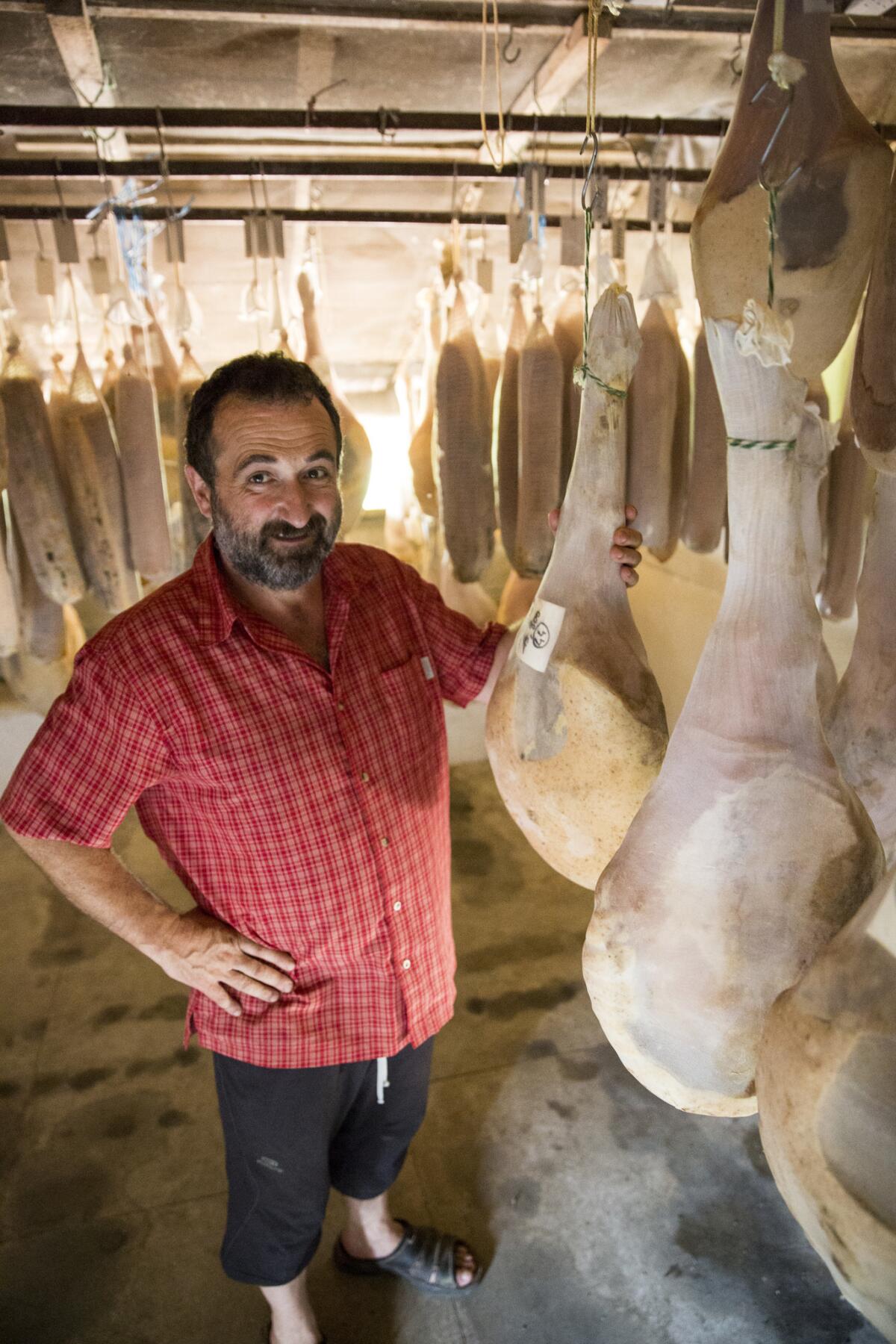
Ramuntxo Lecuona is a local pepper grower and he puts the Espelette spice in almost everything he produces-including hams and sausages.
If we like Espelette peppers we must come to his farm tomorrow, he says. He will show us how he grows these special A.O.C.-protected peppers.
When I tell Ramuntxo I have never heard of Espelette peppers, he shrugs and says he's not surprised.
"We don't send the pepper all over," he says. "That is not the Basque way."
"Here, we have a saying: 'It's not about the zeros.' You understand? For the French Basque, getting money, making money, it's not the most important thing."
The next day we delay our journey to St.-Jean and instead visit Ramuntxo on his farm.
He takes us through a field with thousands of waist-high plants laden with fragrant red peppers that are ready for picking. We cross the road to visit his pigs, which forage freely in a grove of acorn trees.
Then we eat: slices of warm green and red tomatoes, sprinkled with piment d'Espelette, on rounds of toasted baguette; platters of green Espelette peppers fried in olive oil and tossed with sea salt; chewy coins of saucisson sec and a ramekin of duck rillettes, both seasoned with the pepper spice; and thin sheets of jambon de Bayonne that melt in our mouths. All washed down with the slightly fizzy local white wine known as txakolina.
For dessert Ramuntxo serves wedges of ewe's milk cheese along with homemade black cherry jam.
Somehow the day gets away from us. Driving to St.-Jean is out of the question.
Not to worry, says Ramuntxo. Another night in Espelette will be better anyway. There is the beautiful 16th century church, St.-Etienne, to visit. Did we know that the first Miss France is buried there? We did not.
And perhaps a drive in the afternoon in our deux chevaux to visit his friend Dominique Massonde, in nearby Ainhoa, who makes the most delicious Basque cake anywhere. Have we sampled the Basque cake made with preserved cherries?
We have not. "Well," says Ramuntxo, "you have much to see. Perhaps you should save a trip to St.-Jean-de-Luz for another time."
Perhaps we should.
Peppers with a Basque past may have a California future
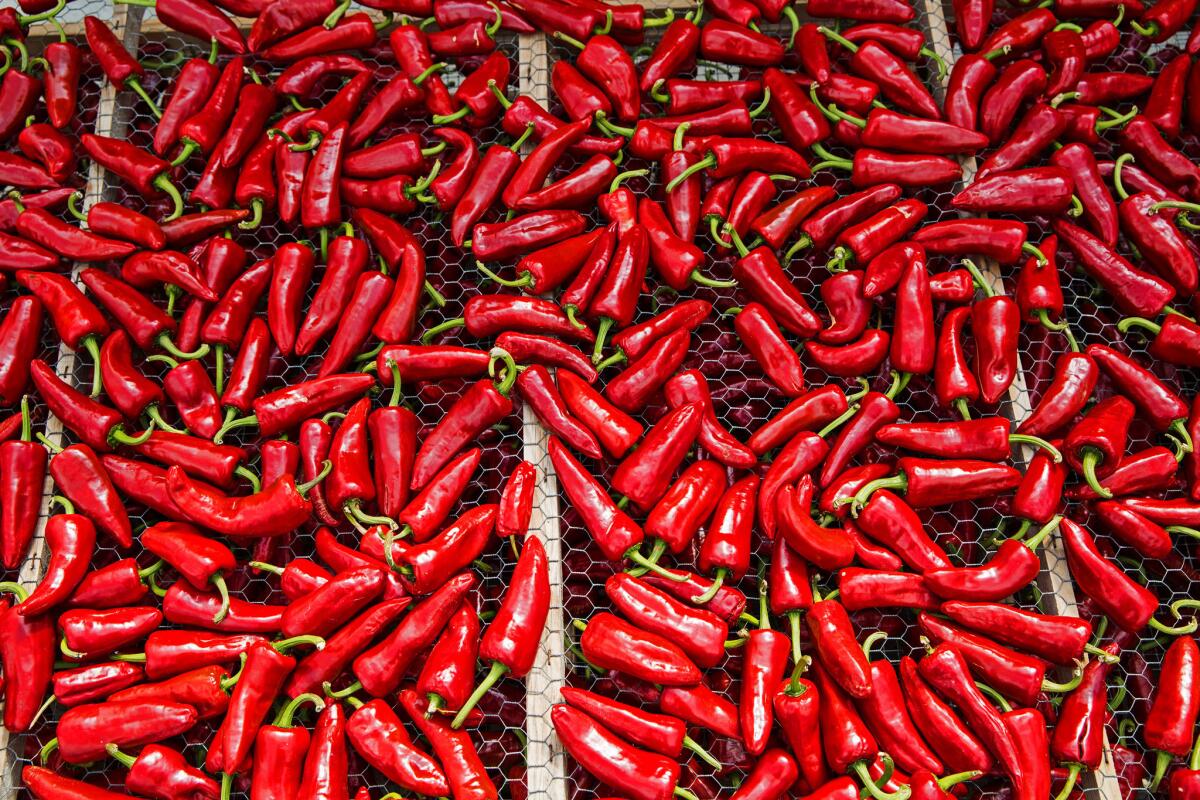
The famous Espelette pepper won AOC status (appellation d’origine controlee) in 1999. It’s the only AOC pepper in the world and has been cultivated here for over 300 years.
The way Ramuntxo Lecuona tells the story, there would be no Espelette peppers if Basque farmers weren't so cheap.
Lecuona, president of the Syndicat du Piment in Espelette, said a Basque sailor who accompanied Christopher Columbus to the Americas on his second voyage in 1493 brought the peppers back with him, "but the local farmers didn't care about it. It was their wives who grew it."
The women found the best places in the garden for the plants, babied them, then strung them with kitchen twine and draped them on the facades of their homes to dry.
"Their husbands gave them no money. So the women sold their peppers at the market and then kept the money secret from their husbands."
In fact there's an expression in the French Basque country — l'argent de piment (pepper money) — that refers to money made selling this or that on the side.
You'll still see garlands of bright red peppers decorating the whitewashed houses of Espelette, but, said Lecuona, that's just for the tourists who come to take pictures.
These days the peppers are dried flat on mesh tables stacked one atop the other and then finished in special ovens at 140 degrees.
At least several California farmers grow and sell what they call Espelette peppers and powder.
Kenter Canyon Farms in Fillmore started selling the freshly ground spice last fall at local farmers markets and plans to do it again this year.
"I expect we'll have whole, fresh Espelette peppers at the markets in late July, and we'll sell Espelette powder in August and September," said Andrea Crawford, who, with her husband, Robert Dedlow, owns Kenter Canyon. "It's very small production, and we do it more because we love it than anything else," she says.
They got their seed from Alex Weiser of Weiser Family Farms, who last year sold ristras, or strung chiles, at the Wednesday Santa Monica market.
"I haven't been to Espelette to see how they grow the peppers over there, but I'd love to go," she said.
Savor the flavors of jambon de Bayonne, Basque cake and more
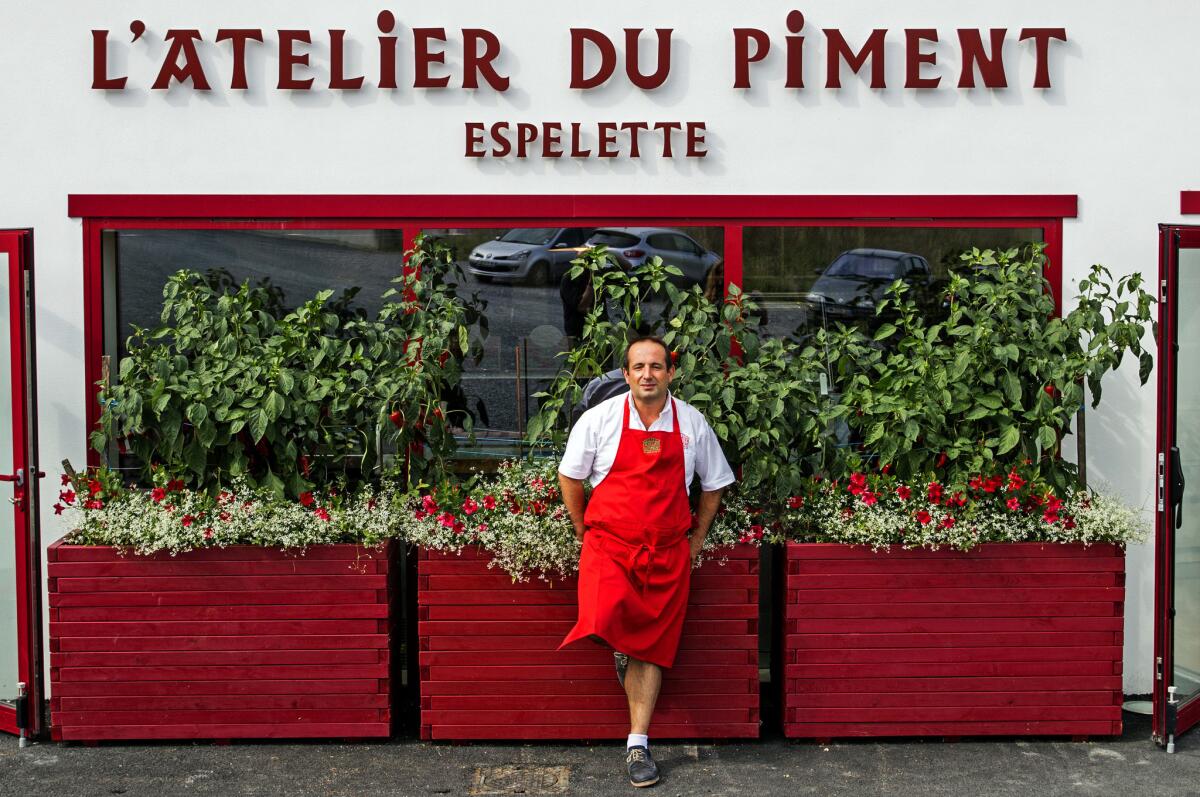
Ramuntxo Pochelu is a pepper producer and owner of Atelier du Piment. He also runs a cooking school teaching Basque dishes based on Espelette peppers.
The best place to learn about (and taste) Espelette peppers is Atelier du Piment just outside of town. Owner-grower Ramuntxo Pochelu provides tours, tastings and a cooking demonstration (reservations required) focused on the red peppers.
There's also a gift shop that sells local cheeses, charcuterie, piment d'Espelette products (spices, oils, mustards) and Basque wines such as txakolina. Info: Open 9 a.m.-7 p.m. daily, www.atelierdupiment.com.
Chocolate-making has been a French Basque specialty since the 1500s, when Portuguese Jews, artisans of whipping up a frothy drink made with chocolate, were expelled, eventually resettling in Bayonne.
Antton Chocolatier, in the heart of Espelette, specializes in chocolate items made with Espelette pepper. (Try the dark chocolate ganache.) They also offer free tours of the chocolate factory, with tastings. Info: Open 9:30 a.m.-7:30 p.m., www.chocolats-antton.com
Gâteau Basque, or Basque cake, isn't just another fancy French dessert. It's a big deal and emblematic of the whole region.
There are rules and regulations about what can go in it (almond flour only, no almond flavoring), a cake museum (in Sare and worth the trip) and an annual competition to see who makes the best.
So who does make the best Basque cake? We like Dominique Massonde's version of his grandmother's cake. He's the chef at Maison Oppoca in Ainhoa, and if you dine at his restaurant you can also sample his excellent axoa (veal with Espelette peppers) and traditional piperade made with the house sausages. Info: www.oppoca.com
You'd better like ham if you're going to visit the French Basque country. In particular, the region's famous jambon de Bayonne.
As with Basque cake there are all sorts of rules and regulations about what, exactly, makes a Bayonne ham. It can come only from one of eight breeds of pigs; the animals cannot be fed any chemicals, antibiotics or other unusual ingredients; and it must be air-dried for a minimum of seven months.
There is, of course, a festival every year on Easter weekend in Bayonne to celebrate their glorious jambon. At it, you can sample the best from 30 Bayonne ham producers.
Or you could just ask for a ham sandwich in just about any bar in the region. Info: jambon-de-bayonne.com/en
What to see on the drive: Napoleon III’s summer home, pelota being played, more
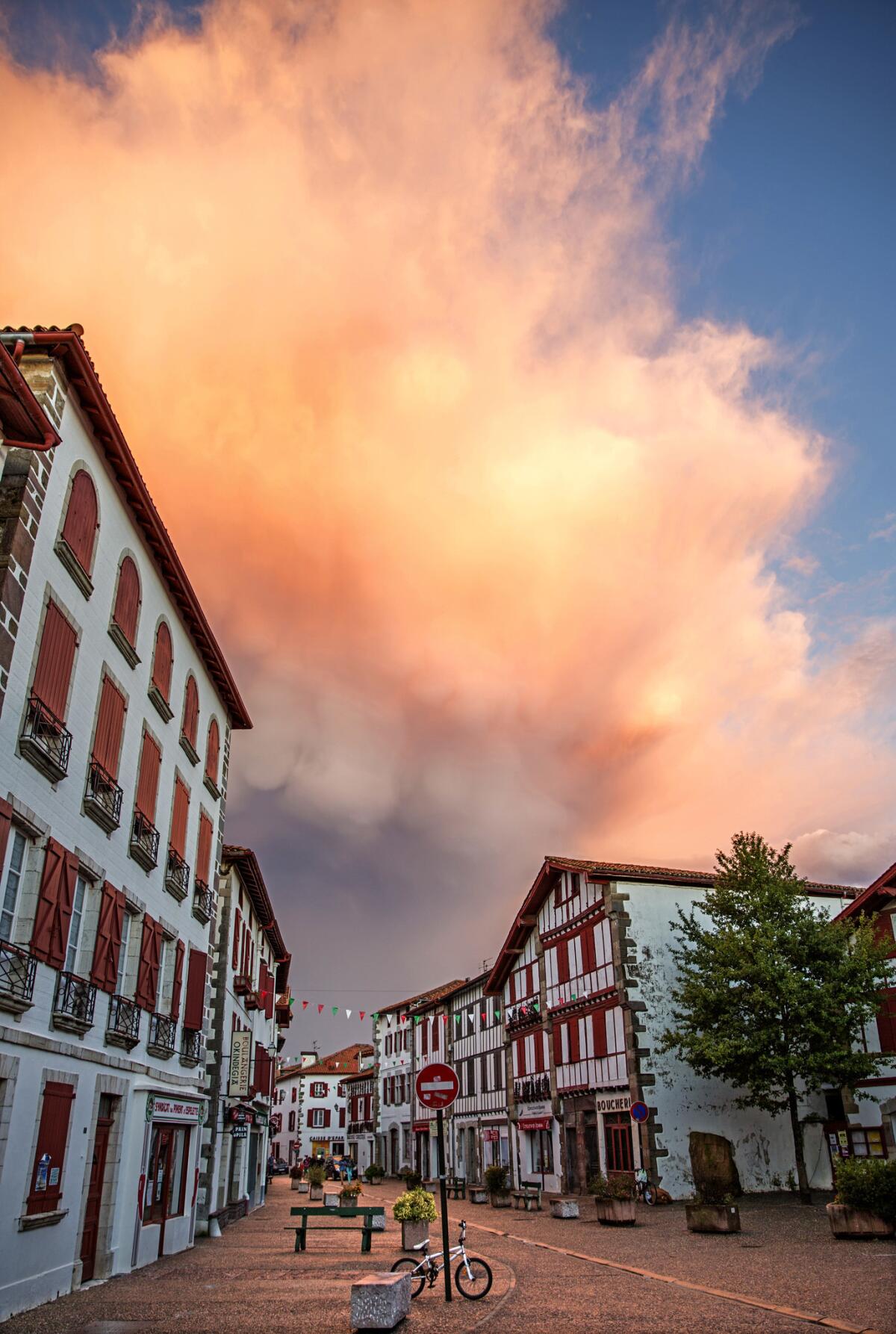
Looking down the street we see traditional white stone Labourd houses which feature timbered facades and stone lintels and shutters painted red.
You could do a circuit through the French Basque countryside in a day starting from Biarritz or Bayonne (about 40 or so miles from either), but it's more practical and enjoyable to make it a two-day trip, stopping overnight in Espelette or Ainhoa.
Some suggestions for a driving tour:
Biarritz: It's fun to walk around and take in the posh surroundings such as the Hôtel du Palais, once the summer home of Napoleon III and Empress Eugénie. More pedestrian but much livelier is the covered market with its two halls: one for fruit and vegetables, the other for fish. There are a lot of little cafés in and around the market area that are ideal for breakfast or lunch.
Bidart: Head south along the coastal road, Avenue de Biarritz, past some of the famous surfing beaches, to Bidart and stop at Moulin de Bassilour, an old bakery and restaurant with a waterwheel used to grind flours for traditional Basque sheepherder's bread and Basque cakes.
St.-Pée-sur-Nivelle: Every little town in France's Basque country has three things in common: the village mairie (town hall), a church and a pelota court. It's a fascinating sport to watch, and if you don't know anything about it, consider visiting the pelota museum here where you can see the sport demonstrated and learn about its importance in Basque culture.
Espelette: The town hall is in a 16th century castle where you'll find an exhibit dedicated to Agnès Souret, who came from Espelette and was the first woman to win the Most Beautiful Woman in France award (Miss France) in 1920. Then visit the village church, St.-Etienne, where she is buried.
If you go to Espelette, France
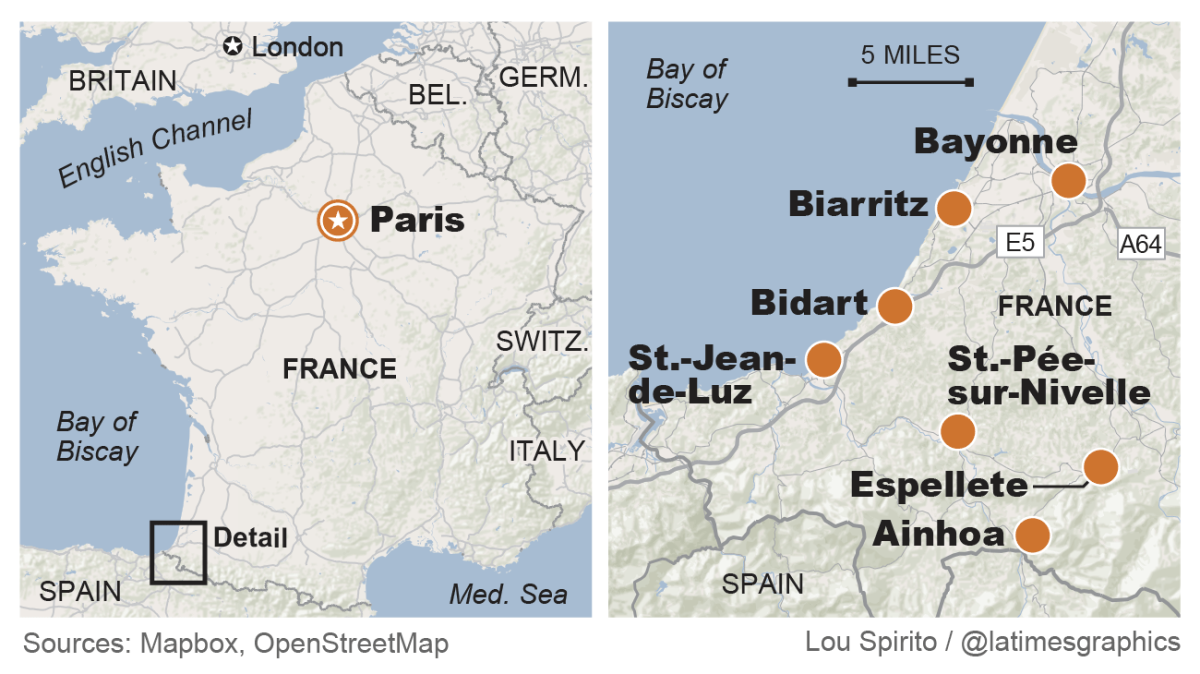
THE BEST WAY TO ESPELETTE, FRANCE
From LAX, Air France, Delta and KLM offer connecting service (change of planes) to Bordeaux. Restricted round-trip fares from $1,516 to $2,078.
Bordeaux is the gateway to the French Basque country. From there you can rent a car, but for less than $40 you can zip down to Biarritz on the train, in less time, and rent a car there. There are eight direct trains a day between Bordeaux and Biarritz. Book in advance with www.thetrainline-europe.com.
It's only a half-hour drive from there to Espelette (unless you're driving a deux chevaux, and then you'd better double it — at least).
RENTING A CAR
Several companies rent restored Citroën 2CVs in southwest France, but frankly, I wouldn't recommend it. Yes, they're cool-looking and a great way to meet local villagers (everyone will want to take a selfie with your car), but they're also slo-o-o-o-w, loud, expensive and slightly dangerous (we held our breath every time we had to turn the corner, hoping our little tin shed on wheels wouldn't tip over).
Our car came from World Safary Co. (2cv-location.fr), which has a fleet of 30 fully rebuilt 2CVs in pristine condition. They don't come cheap: Expect to pay about $223 per day.
TELEPHONES
To call the numbers below from the U.S., dial 011 (the international dialing code), 33 (country code for France), and the nine-digit local number.
WHERE TO STAY
Hôtel Euzkadi, 285 Karrika Nagusia, Espelette, France; 5-5993-9188, www.hotel-restaurant-euzkadi.com. Rooms from $80 to $125.
Hôtel La Maison Oppoca, Le bourg, Ainhoa, France; 5-5929-9072, www.oppoca.com. Rooms from $97 to $243, breakfast included.
WHERE TO EAT
The Hôtel Euzkadi restaurant specializes in traditional Basque country dishes such as axoa (veal), grilled Ibaiona pork or, if you're adventurous, lamb sweetbreads. Special four-course menu of local dishes for $32.
Le Maison Oppoca. Chef Dominique Massonde is one of the area's culinary stars. His tarte à la pipérade, local charcuterie and gâteau Basque make a fine country meal. Three-course local menu from $42.
TO LEARN MORE
Aquitaine Tourism Board, 4/5 Place Jean Jaures, Bordeaux, France; www.tourisme-aquitaine.fr/en/
::
More Europe off the beaten path:
Reviving a faded resort past with art, amusements in Margate, England
Porto, Portugal, turns on the charm, pours forth history
On Sweden's rocky west coast, a solid setting for stories
Feeling like royalty in the majestic Old City of Luxembourg
A secret range of stunning mountains? Hikers, meet Slovakia's High Tatras
Sign up for The Wild
We’ll help you find the best places to hike, bike and run, as well as the perfect silent spots for meditation and yoga.
You may occasionally receive promotional content from the Los Angeles Times.



